Financial Management Analysis of Jurys Inn Hotel Performance
VerifiedAdded on 2023/06/13
|11
|2735
|141
Report
AI Summary
This report provides a comprehensive financial management analysis of Jurys Inn, a hospitality firm operating in Great Britain and Northern England, focusing on its fiscal efficiency through ratio analysis. It evaluates profitability, sustainability (liquidity), and gearing ratios for the years 2019 and 2020, identifying unfavorable trends in revenue and financial condition, alongside increasing leverage. The report discusses the importance of understanding financial ratios for hospitality administration, including their role in planning, decision-making, assessing long-term solvency, profitability, operational effectiveness, and cost control. It also addresses the advantages and drawbacks of accounting ratios as a decision-making tool, highlighting their limitations due to descriptive approaches, accounting standards variations, and reliance on historical data. The analysis concludes that Jurys Inn's financial performance is deteriorating, necessitating improvements in daily operations and financial management strategies; students can find similar solved assignments and study resources on Desklib.

Financial Management
for the Hotel Industry
for the Hotel Industry
Paraphrase This Document
Need a fresh take? Get an instant paraphrase of this document with our AI Paraphraser
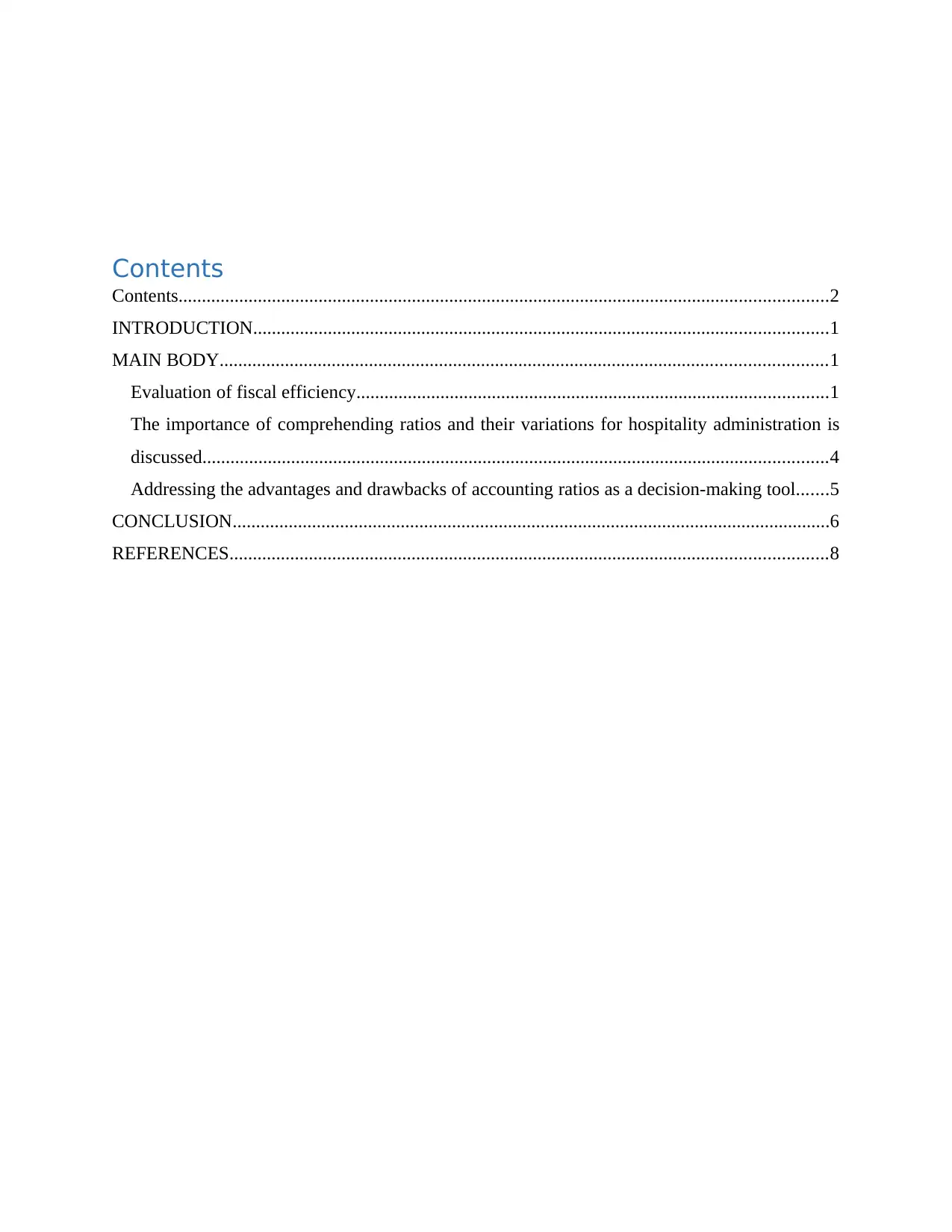
Contents
Contents...........................................................................................................................................2
INTRODUCTION...........................................................................................................................1
MAIN BODY..................................................................................................................................1
Evaluation of fiscal efficiency.....................................................................................................1
The importance of comprehending ratios and their variations for hospitality administration is
discussed......................................................................................................................................4
Addressing the advantages and drawbacks of accounting ratios as a decision-making tool.......5
CONCLUSION................................................................................................................................6
REFERENCES................................................................................................................................8
Contents...........................................................................................................................................2
INTRODUCTION...........................................................................................................................1
MAIN BODY..................................................................................................................................1
Evaluation of fiscal efficiency.....................................................................................................1
The importance of comprehending ratios and their variations for hospitality administration is
discussed......................................................................................................................................4
Addressing the advantages and drawbacks of accounting ratios as a decision-making tool.......5
CONCLUSION................................................................................................................................6
REFERENCES................................................................................................................................8

⊘ This is a preview!⊘
Do you want full access?
Subscribe today to unlock all pages.

Trusted by 1+ million students worldwide
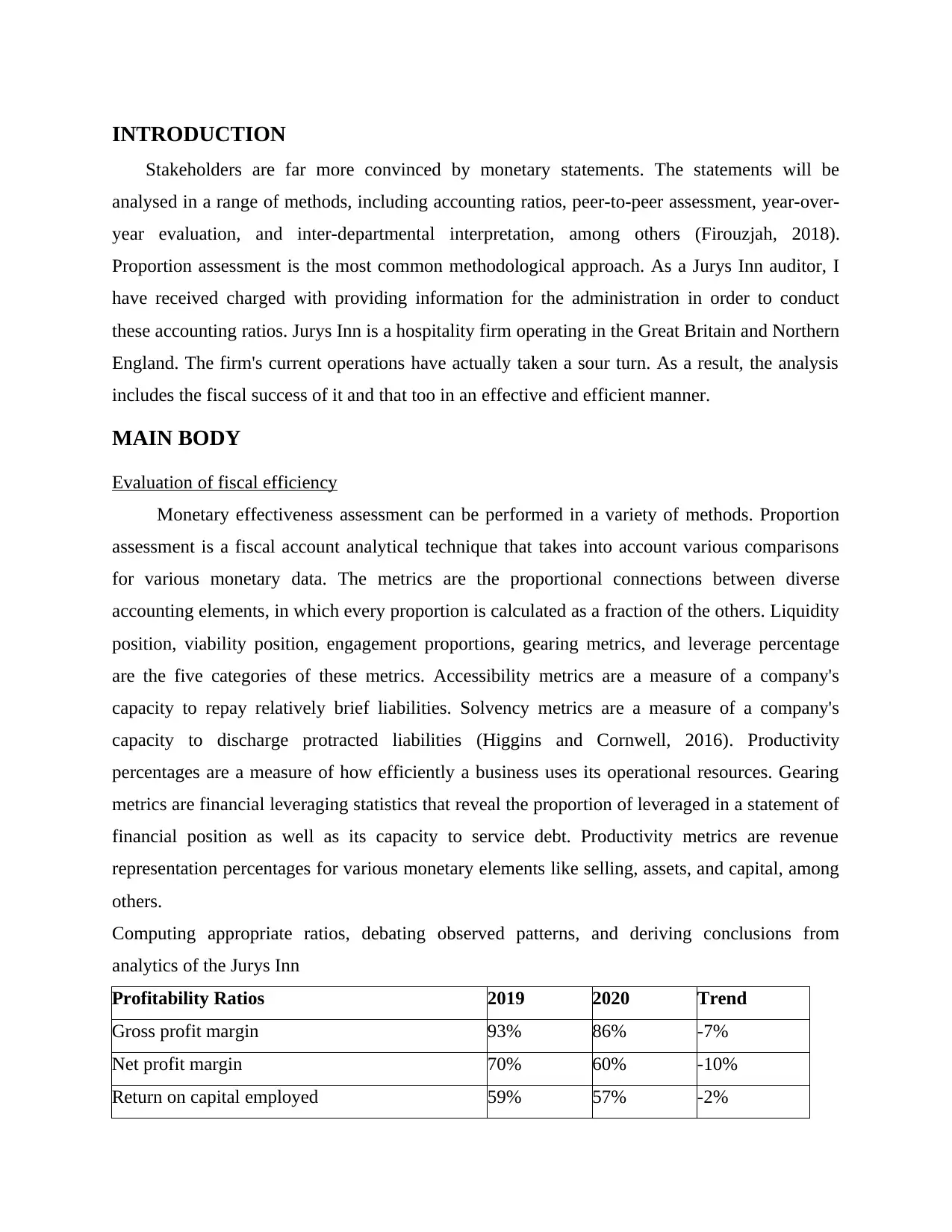
INTRODUCTION
Stakeholders are far more convinced by monetary statements. The statements will be
analysed in a range of methods, including accounting ratios, peer-to-peer assessment, year-over-
year evaluation, and inter-departmental interpretation, among others (Firouzjah, 2018).
Proportion assessment is the most common methodological approach. As a Jurys Inn auditor, I
have received charged with providing information for the administration in order to conduct
these accounting ratios. Jurys Inn is a hospitality firm operating in the Great Britain and Northern
England. The firm's current operations have actually taken a sour turn. As a result, the analysis
includes the fiscal success of it and that too in an effective and efficient manner.
MAIN BODY
Evaluation of fiscal efficiency
Monetary effectiveness assessment can be performed in a variety of methods. Proportion
assessment is a fiscal account analytical technique that takes into account various comparisons
for various monetary data. The metrics are the proportional connections between diverse
accounting elements, in which every proportion is calculated as a fraction of the others. Liquidity
position, viability position, engagement proportions, gearing metrics, and leverage percentage
are the five categories of these metrics. Accessibility metrics are a measure of a company's
capacity to repay relatively brief liabilities. Solvency metrics are a measure of a company's
capacity to discharge protracted liabilities (Higgins and Cornwell, 2016). Productivity
percentages are a measure of how efficiently a business uses its operational resources. Gearing
metrics are financial leveraging statistics that reveal the proportion of leveraged in a statement of
financial position as well as its capacity to service debt. Productivity metrics are revenue
representation percentages for various monetary elements like selling, assets, and capital, among
others.
Computing appropriate ratios, debating observed patterns, and deriving conclusions from
analytics of the Jurys Inn
Profitability Ratios 2019 2020 Trend
Gross profit margin 93% 86% -7%
Net profit margin 70% 60% -10%
Return on capital employed 59% 57% -2%
Stakeholders are far more convinced by monetary statements. The statements will be
analysed in a range of methods, including accounting ratios, peer-to-peer assessment, year-over-
year evaluation, and inter-departmental interpretation, among others (Firouzjah, 2018).
Proportion assessment is the most common methodological approach. As a Jurys Inn auditor, I
have received charged with providing information for the administration in order to conduct
these accounting ratios. Jurys Inn is a hospitality firm operating in the Great Britain and Northern
England. The firm's current operations have actually taken a sour turn. As a result, the analysis
includes the fiscal success of it and that too in an effective and efficient manner.
MAIN BODY
Evaluation of fiscal efficiency
Monetary effectiveness assessment can be performed in a variety of methods. Proportion
assessment is a fiscal account analytical technique that takes into account various comparisons
for various monetary data. The metrics are the proportional connections between diverse
accounting elements, in which every proportion is calculated as a fraction of the others. Liquidity
position, viability position, engagement proportions, gearing metrics, and leverage percentage
are the five categories of these metrics. Accessibility metrics are a measure of a company's
capacity to repay relatively brief liabilities. Solvency metrics are a measure of a company's
capacity to discharge protracted liabilities (Higgins and Cornwell, 2016). Productivity
percentages are a measure of how efficiently a business uses its operational resources. Gearing
metrics are financial leveraging statistics that reveal the proportion of leveraged in a statement of
financial position as well as its capacity to service debt. Productivity metrics are revenue
representation percentages for various monetary elements like selling, assets, and capital, among
others.
Computing appropriate ratios, debating observed patterns, and deriving conclusions from
analytics of the Jurys Inn
Profitability Ratios 2019 2020 Trend
Gross profit margin 93% 86% -7%
Net profit margin 70% 60% -10%
Return on capital employed 59% 57% -2%
Paraphrase This Document
Need a fresh take? Get an instant paraphrase of this document with our AI Paraphraser

Total Asset turnover (times) 0.83 0.95 0.12
Working capital turnover( Times) 2.6 3 0.40
Liquidity ratios -
Current ratio 2.29 2 (0.29)
Quick ratio 1.2 1.13 (0.07)
Debtor Day 129 131 2.00
Creditor Days 584 396 (188.00)
Gearing Ratios -
Debt to equity Ratio 30% 36% 6%
Debt Ratio 23% 27% 4%
Interest Coverage Ratio 159 168 9.00
Jurys Inn's Profitability
Analysis of Patterns: The revenue measure of Jurys Inn's company is showing
unfavourable patterns. It tends to exhibit lower values in all revenue indicating metrics
than that of the prior quarter. The overall income margin in 2019 was 93 percent, whereas
it is now 86 percent in 2020. In 2019, the aggregate revenue margin was 60%, but it is
now 60% in 2020. In addition, the yield on investment invested was 59 percent in 2019,
but is now 57 percent in 2020. Jurys Inn is seeing a downward trajectory in all
profitability ratios, with a total income margin of 7%, earnings before interest and taxes
of -10%, and a yield on assets invested of 2%, correspondingly. Productivity metrics, on
either side, are indicating an upward tendency in 2020 compared to 2019. In 2019,
overall assets conversion was 0.83 occasions, compared to 0.95 times in 2020, and
operating capacity circulation is three times, compared to 3 times in 2019. Overall
resource rotation is expanding at a rate of 0.12 times, while operating resource revolution
is growing at a rate of 0.40 times (Kalkavan and Ersin, 2019).
Outcome: Declining yield on assets indicated that perhaps the firm's total income
margins revenue were inadequate in relation to revenue generated, as well as a poor yield
on initial invested. Due to the declining character, it may be predicted that Jurys Inn will
incur higher operational and finance costs in 2020 than in 2019. Furthermore, increased
overall property turns and cash flow volatility indicate excellent workplace property and
Working capital turnover( Times) 2.6 3 0.40
Liquidity ratios -
Current ratio 2.29 2 (0.29)
Quick ratio 1.2 1.13 (0.07)
Debtor Day 129 131 2.00
Creditor Days 584 396 (188.00)
Gearing Ratios -
Debt to equity Ratio 30% 36% 6%
Debt Ratio 23% 27% 4%
Interest Coverage Ratio 159 168 9.00
Jurys Inn's Profitability
Analysis of Patterns: The revenue measure of Jurys Inn's company is showing
unfavourable patterns. It tends to exhibit lower values in all revenue indicating metrics
than that of the prior quarter. The overall income margin in 2019 was 93 percent, whereas
it is now 86 percent in 2020. In 2019, the aggregate revenue margin was 60%, but it is
now 60% in 2020. In addition, the yield on investment invested was 59 percent in 2019,
but is now 57 percent in 2020. Jurys Inn is seeing a downward trajectory in all
profitability ratios, with a total income margin of 7%, earnings before interest and taxes
of -10%, and a yield on assets invested of 2%, correspondingly. Productivity metrics, on
either side, are indicating an upward tendency in 2020 compared to 2019. In 2019,
overall assets conversion was 0.83 occasions, compared to 0.95 times in 2020, and
operating capacity circulation is three times, compared to 3 times in 2019. Overall
resource rotation is expanding at a rate of 0.12 times, while operating resource revolution
is growing at a rate of 0.40 times (Kalkavan and Ersin, 2019).
Outcome: Declining yield on assets indicated that perhaps the firm's total income
margins revenue were inadequate in relation to revenue generated, as well as a poor yield
on initial invested. Due to the declining character, it may be predicted that Jurys Inn will
incur higher operational and finance costs in 2020 than in 2019. Furthermore, increased
overall property turns and cash flow volatility indicate excellent workplace property and
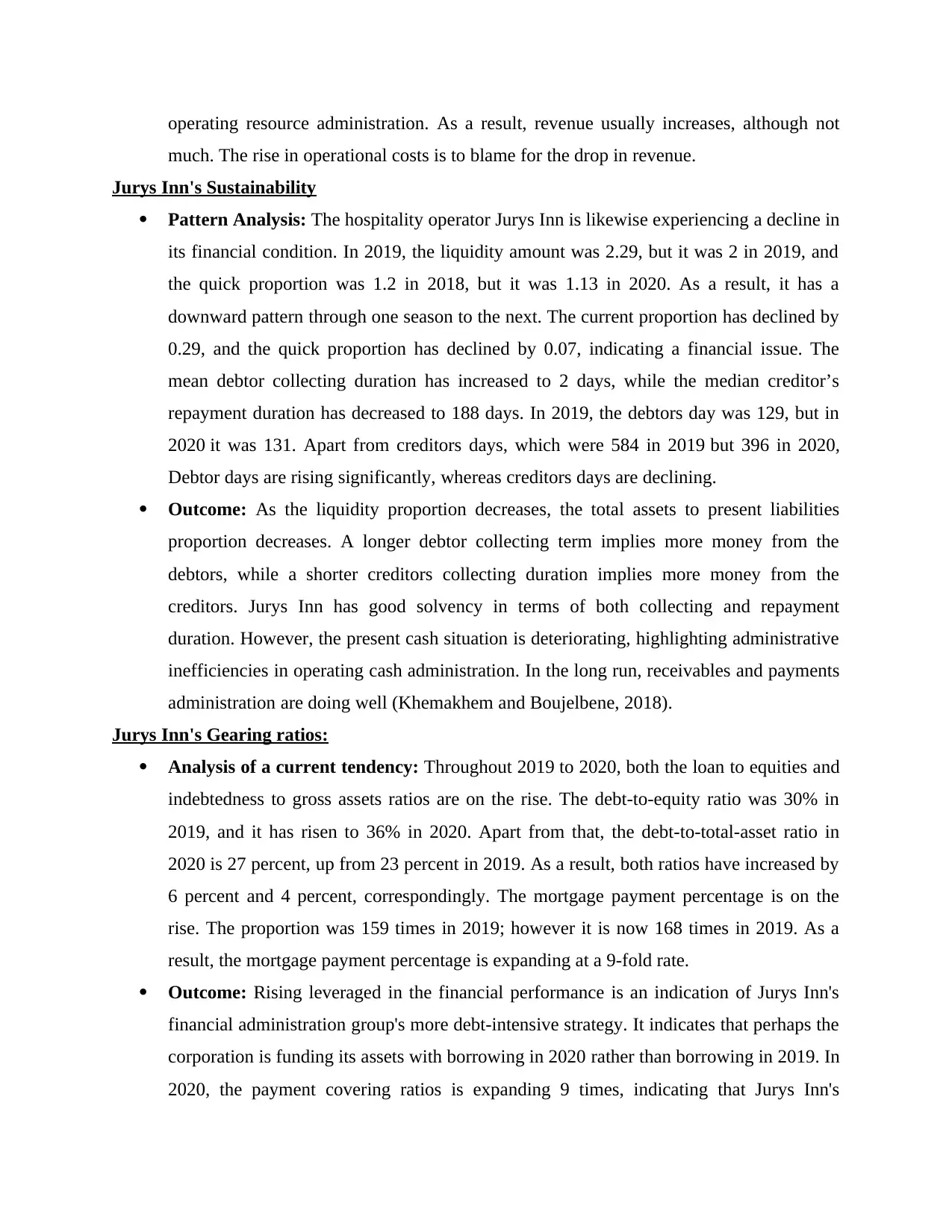
operating resource administration. As a result, revenue usually increases, although not
much. The rise in operational costs is to blame for the drop in revenue.
Jurys Inn's Sustainability
Pattern Analysis: The hospitality operator Jurys Inn is likewise experiencing a decline in
its financial condition. In 2019, the liquidity amount was 2.29, but it was 2 in 2019, and
the quick proportion was 1.2 in 2018, but it was 1.13 in 2020. As a result, it has a
downward pattern through one season to the next. The current proportion has declined by
0.29, and the quick proportion has declined by 0.07, indicating a financial issue. The
mean debtor collecting duration has increased to 2 days, while the median creditor’s
repayment duration has decreased to 188 days. In 2019, the debtors day was 129, but in
2020 it was 131. Apart from creditors days, which were 584 in 2019 but 396 in 2020,
Debtor days are rising significantly, whereas creditors days are declining.
Outcome: As the liquidity proportion decreases, the total assets to present liabilities
proportion decreases. A longer debtor collecting term implies more money from the
debtors, while a shorter creditors collecting duration implies more money from the
creditors. Jurys Inn has good solvency in terms of both collecting and repayment
duration. However, the present cash situation is deteriorating, highlighting administrative
inefficiencies in operating cash administration. In the long run, receivables and payments
administration are doing well (Khemakhem and Boujelbene, 2018).
Jurys Inn's Gearing ratios:
Analysis of a current tendency: Throughout 2019 to 2020, both the loan to equities and
indebtedness to gross assets ratios are on the rise. The debt-to-equity ratio was 30% in
2019, and it has risen to 36% in 2020. Apart from that, the debt-to-total-asset ratio in
2020 is 27 percent, up from 23 percent in 2019. As a result, both ratios have increased by
6 percent and 4 percent, correspondingly. The mortgage payment percentage is on the
rise. The proportion was 159 times in 2019; however it is now 168 times in 2019. As a
result, the mortgage payment percentage is expanding at a 9-fold rate.
Outcome: Rising leveraged in the financial performance is an indication of Jurys Inn's
financial administration group's more debt-intensive strategy. It indicates that perhaps the
corporation is funding its assets with borrowing in 2020 rather than borrowing in 2019. In
2020, the payment covering ratios is expanding 9 times, indicating that Jurys Inn's
much. The rise in operational costs is to blame for the drop in revenue.
Jurys Inn's Sustainability
Pattern Analysis: The hospitality operator Jurys Inn is likewise experiencing a decline in
its financial condition. In 2019, the liquidity amount was 2.29, but it was 2 in 2019, and
the quick proportion was 1.2 in 2018, but it was 1.13 in 2020. As a result, it has a
downward pattern through one season to the next. The current proportion has declined by
0.29, and the quick proportion has declined by 0.07, indicating a financial issue. The
mean debtor collecting duration has increased to 2 days, while the median creditor’s
repayment duration has decreased to 188 days. In 2019, the debtors day was 129, but in
2020 it was 131. Apart from creditors days, which were 584 in 2019 but 396 in 2020,
Debtor days are rising significantly, whereas creditors days are declining.
Outcome: As the liquidity proportion decreases, the total assets to present liabilities
proportion decreases. A longer debtor collecting term implies more money from the
debtors, while a shorter creditors collecting duration implies more money from the
creditors. Jurys Inn has good solvency in terms of both collecting and repayment
duration. However, the present cash situation is deteriorating, highlighting administrative
inefficiencies in operating cash administration. In the long run, receivables and payments
administration are doing well (Khemakhem and Boujelbene, 2018).
Jurys Inn's Gearing ratios:
Analysis of a current tendency: Throughout 2019 to 2020, both the loan to equities and
indebtedness to gross assets ratios are on the rise. The debt-to-equity ratio was 30% in
2019, and it has risen to 36% in 2020. Apart from that, the debt-to-total-asset ratio in
2020 is 27 percent, up from 23 percent in 2019. As a result, both ratios have increased by
6 percent and 4 percent, correspondingly. The mortgage payment percentage is on the
rise. The proportion was 159 times in 2019; however it is now 168 times in 2019. As a
result, the mortgage payment percentage is expanding at a 9-fold rate.
Outcome: Rising leveraged in the financial performance is an indication of Jurys Inn's
financial administration group's more debt-intensive strategy. It indicates that perhaps the
corporation is funding its assets with borrowing in 2020 rather than borrowing in 2019. In
2020, the payment covering ratios is expanding 9 times, indicating that Jurys Inn's
⊘ This is a preview!⊘
Do you want full access?
Subscribe today to unlock all pages.

Trusted by 1+ million students worldwide
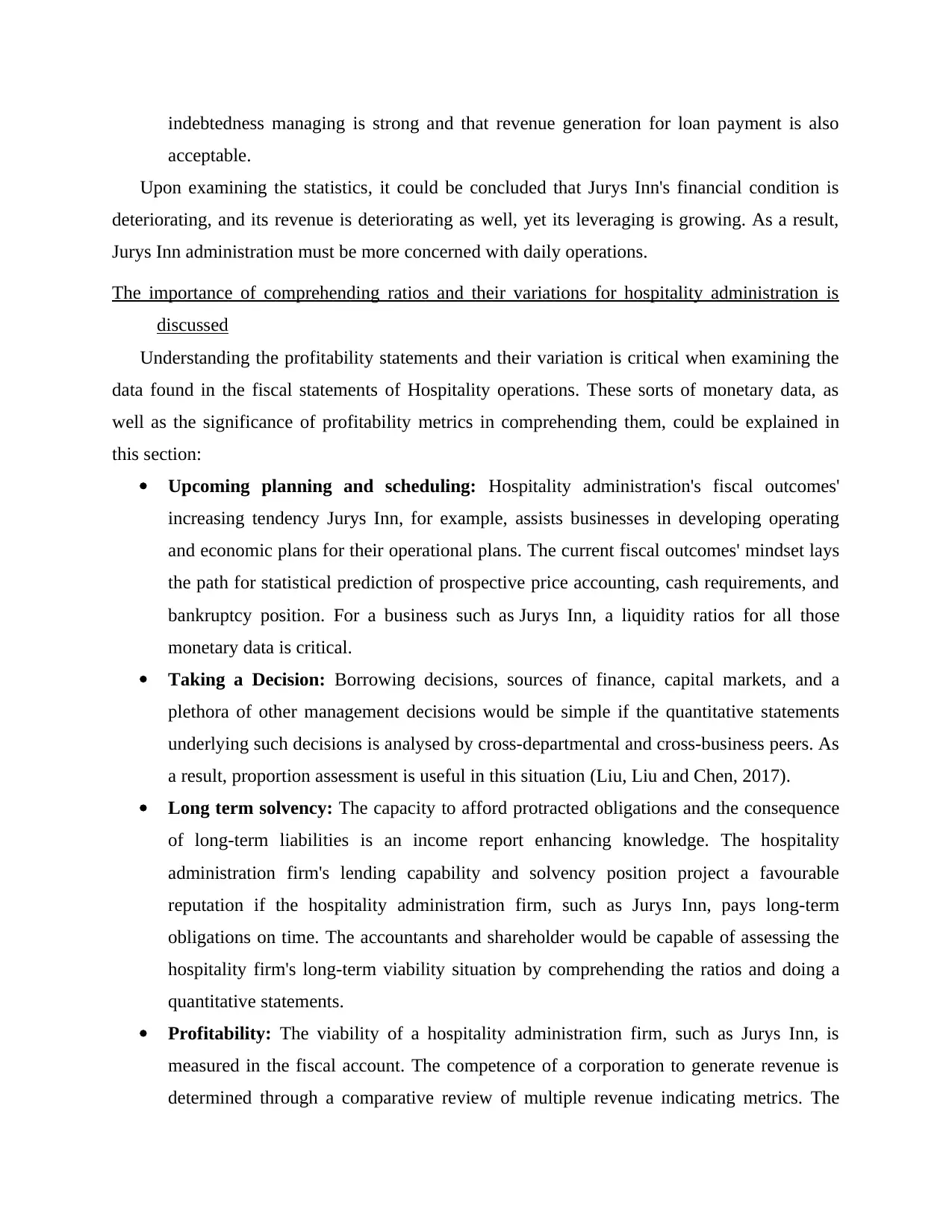
indebtedness managing is strong and that revenue generation for loan payment is also
acceptable.
Upon examining the statistics, it could be concluded that Jurys Inn's financial condition is
deteriorating, and its revenue is deteriorating as well, yet its leveraging is growing. As a result,
Jurys Inn administration must be more concerned with daily operations.
The importance of comprehending ratios and their variations for hospitality administration is
discussed
Understanding the profitability statements and their variation is critical when examining the
data found in the fiscal statements of Hospitality operations. These sorts of monetary data, as
well as the significance of profitability metrics in comprehending them, could be explained in
this section:
Upcoming planning and scheduling: Hospitality administration's fiscal outcomes'
increasing tendency Jurys Inn, for example, assists businesses in developing operating
and economic plans for their operational plans. The current fiscal outcomes' mindset lays
the path for statistical prediction of prospective price accounting, cash requirements, and
bankruptcy position. For a business such as Jurys Inn, a liquidity ratios for all those
monetary data is critical.
Taking a Decision: Borrowing decisions, sources of finance, capital markets, and a
plethora of other management decisions would be simple if the quantitative statements
underlying such decisions is analysed by cross-departmental and cross-business peers. As
a result, proportion assessment is useful in this situation (Liu, Liu and Chen, 2017).
Long term solvency: The capacity to afford protracted obligations and the consequence
of long-term liabilities is an income report enhancing knowledge. The hospitality
administration firm's lending capability and solvency position project a favourable
reputation if the hospitality administration firm, such as Jurys Inn, pays long-term
obligations on time. The accountants and shareholder would be capable of assessing the
hospitality firm's long-term viability situation by comprehending the ratios and doing a
quantitative statements.
Profitability: The viability of a hospitality administration firm, such as Jurys Inn, is
measured in the fiscal account. The competence of a corporation to generate revenue is
determined through a comparative review of multiple revenue indicating metrics. The
acceptable.
Upon examining the statistics, it could be concluded that Jurys Inn's financial condition is
deteriorating, and its revenue is deteriorating as well, yet its leveraging is growing. As a result,
Jurys Inn administration must be more concerned with daily operations.
The importance of comprehending ratios and their variations for hospitality administration is
discussed
Understanding the profitability statements and their variation is critical when examining the
data found in the fiscal statements of Hospitality operations. These sorts of monetary data, as
well as the significance of profitability metrics in comprehending them, could be explained in
this section:
Upcoming planning and scheduling: Hospitality administration's fiscal outcomes'
increasing tendency Jurys Inn, for example, assists businesses in developing operating
and economic plans for their operational plans. The current fiscal outcomes' mindset lays
the path for statistical prediction of prospective price accounting, cash requirements, and
bankruptcy position. For a business such as Jurys Inn, a liquidity ratios for all those
monetary data is critical.
Taking a Decision: Borrowing decisions, sources of finance, capital markets, and a
plethora of other management decisions would be simple if the quantitative statements
underlying such decisions is analysed by cross-departmental and cross-business peers. As
a result, proportion assessment is useful in this situation (Liu, Liu and Chen, 2017).
Long term solvency: The capacity to afford protracted obligations and the consequence
of long-term liabilities is an income report enhancing knowledge. The hospitality
administration firm's lending capability and solvency position project a favourable
reputation if the hospitality administration firm, such as Jurys Inn, pays long-term
obligations on time. The accountants and shareholder would be capable of assessing the
hospitality firm's long-term viability situation by comprehending the ratios and doing a
quantitative statements.
Profitability: The viability of a hospitality administration firm, such as Jurys Inn, is
measured in the fiscal account. The competence of a corporation to generate revenue is
determined through a comparative review of multiple revenue indicating metrics. The
Paraphrase This Document
Need a fresh take? Get an instant paraphrase of this document with our AI Paraphraser
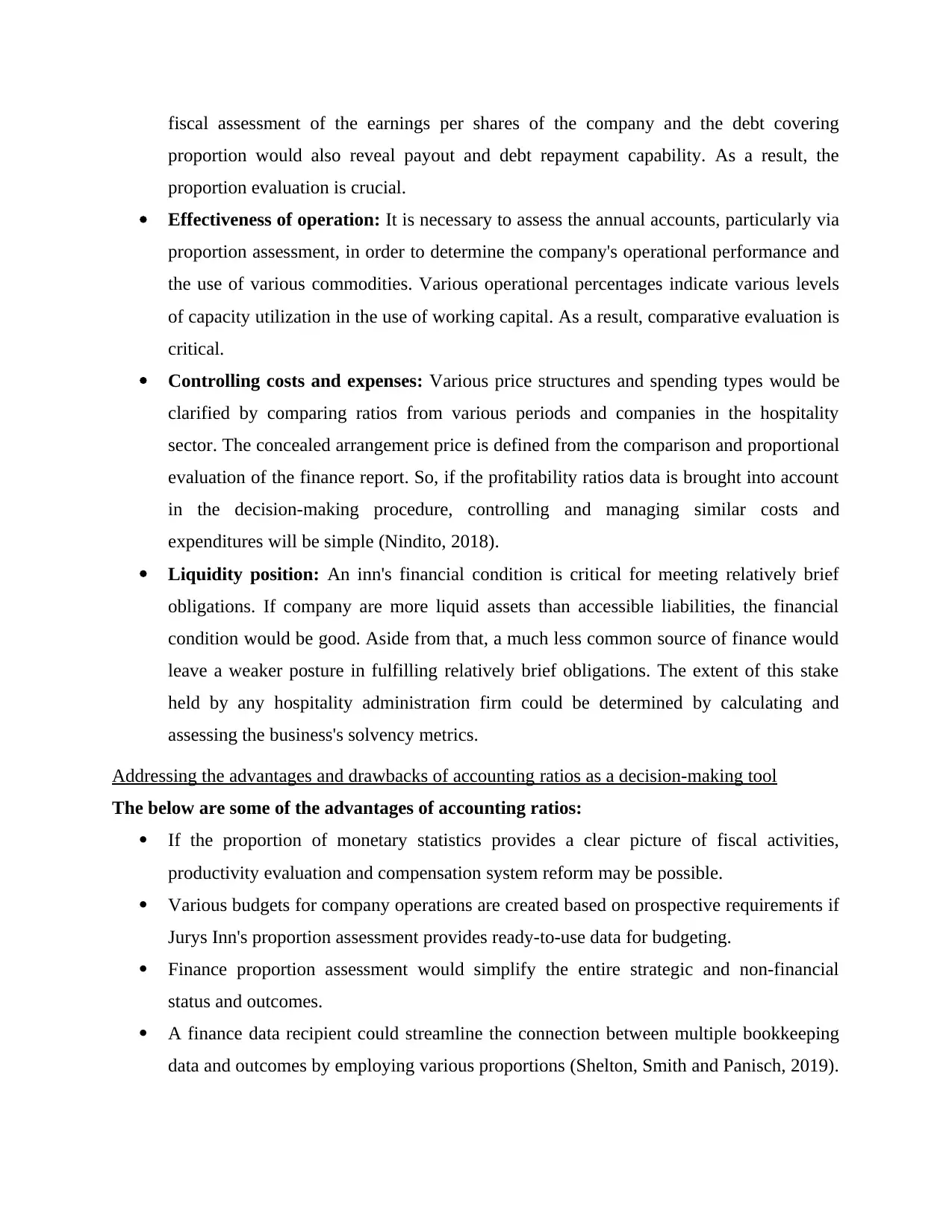
fiscal assessment of the earnings per shares of the company and the debt covering
proportion would also reveal payout and debt repayment capability. As a result, the
proportion evaluation is crucial.
Effectiveness of operation: It is necessary to assess the annual accounts, particularly via
proportion assessment, in order to determine the company's operational performance and
the use of various commodities. Various operational percentages indicate various levels
of capacity utilization in the use of working capital. As a result, comparative evaluation is
critical.
Controlling costs and expenses: Various price structures and spending types would be
clarified by comparing ratios from various periods and companies in the hospitality
sector. The concealed arrangement price is defined from the comparison and proportional
evaluation of the finance report. So, if the profitability ratios data is brought into account
in the decision-making procedure, controlling and managing similar costs and
expenditures will be simple (Nindito, 2018).
Liquidity position: An inn's financial condition is critical for meeting relatively brief
obligations. If company are more liquid assets than accessible liabilities, the financial
condition would be good. Aside from that, a much less common source of finance would
leave a weaker posture in fulfilling relatively brief obligations. The extent of this stake
held by any hospitality administration firm could be determined by calculating and
assessing the business's solvency metrics.
Addressing the advantages and drawbacks of accounting ratios as a decision-making tool
The below are some of the advantages of accounting ratios:
If the proportion of monetary statistics provides a clear picture of fiscal activities,
productivity evaluation and compensation system reform may be possible.
Various budgets for company operations are created based on prospective requirements if
Jurys Inn's proportion assessment provides ready-to-use data for budgeting.
Finance proportion assessment would simplify the entire strategic and non-financial
status and outcomes.
A finance data recipient could streamline the connection between multiple bookkeeping
data and outcomes by employing various proportions (Shelton, Smith and Panisch, 2019).
proportion would also reveal payout and debt repayment capability. As a result, the
proportion evaluation is crucial.
Effectiveness of operation: It is necessary to assess the annual accounts, particularly via
proportion assessment, in order to determine the company's operational performance and
the use of various commodities. Various operational percentages indicate various levels
of capacity utilization in the use of working capital. As a result, comparative evaluation is
critical.
Controlling costs and expenses: Various price structures and spending types would be
clarified by comparing ratios from various periods and companies in the hospitality
sector. The concealed arrangement price is defined from the comparison and proportional
evaluation of the finance report. So, if the profitability ratios data is brought into account
in the decision-making procedure, controlling and managing similar costs and
expenditures will be simple (Nindito, 2018).
Liquidity position: An inn's financial condition is critical for meeting relatively brief
obligations. If company are more liquid assets than accessible liabilities, the financial
condition would be good. Aside from that, a much less common source of finance would
leave a weaker posture in fulfilling relatively brief obligations. The extent of this stake
held by any hospitality administration firm could be determined by calculating and
assessing the business's solvency metrics.
Addressing the advantages and drawbacks of accounting ratios as a decision-making tool
The below are some of the advantages of accounting ratios:
If the proportion of monetary statistics provides a clear picture of fiscal activities,
productivity evaluation and compensation system reform may be possible.
Various budgets for company operations are created based on prospective requirements if
Jurys Inn's proportion assessment provides ready-to-use data for budgeting.
Finance proportion assessment would simplify the entire strategic and non-financial
status and outcomes.
A finance data recipient could streamline the connection between multiple bookkeeping
data and outcomes by employing various proportions (Shelton, Smith and Panisch, 2019).
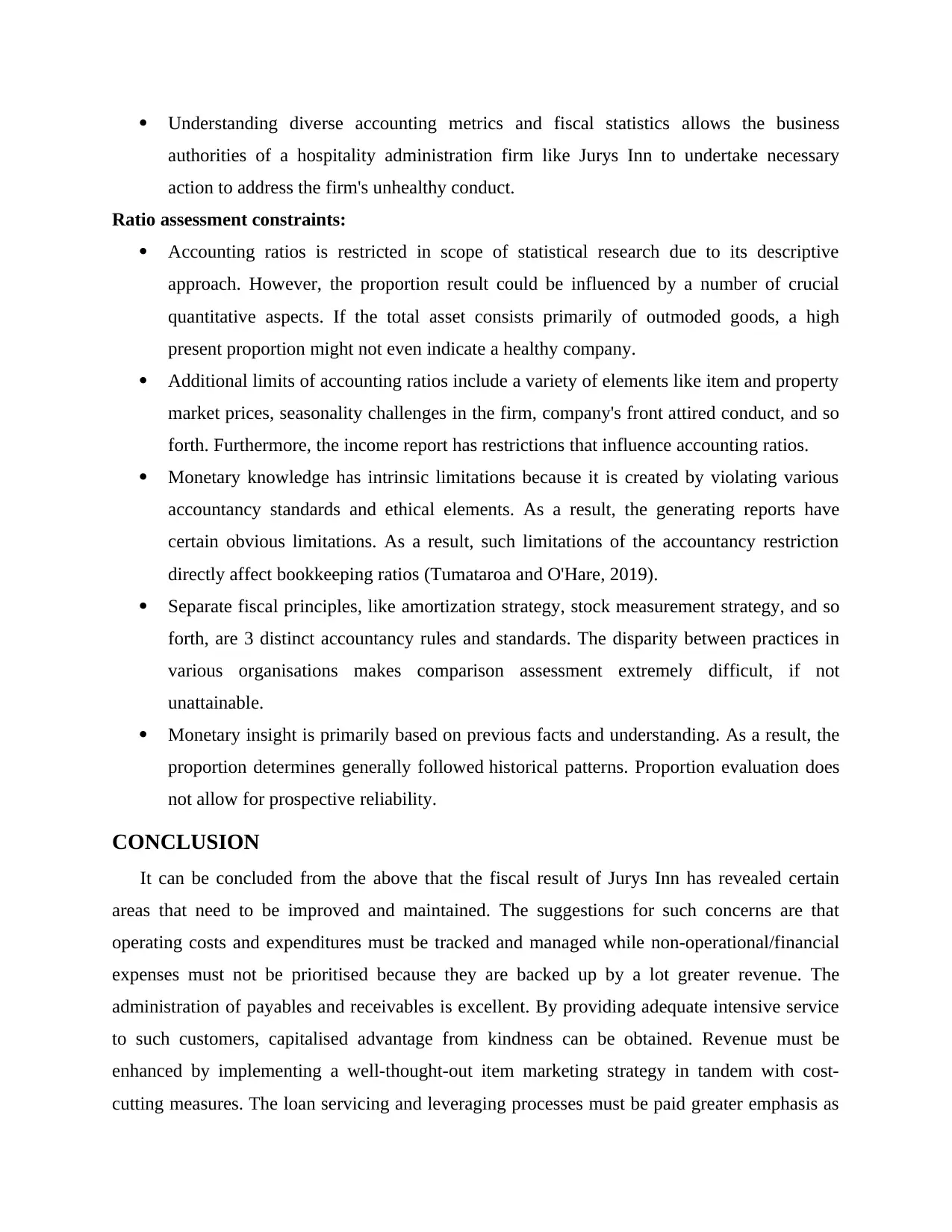
Understanding diverse accounting metrics and fiscal statistics allows the business
authorities of a hospitality administration firm like Jurys Inn to undertake necessary
action to address the firm's unhealthy conduct.
Ratio assessment constraints:
Accounting ratios is restricted in scope of statistical research due to its descriptive
approach. However, the proportion result could be influenced by a number of crucial
quantitative aspects. If the total asset consists primarily of outmoded goods, a high
present proportion might not even indicate a healthy company.
Additional limits of accounting ratios include a variety of elements like item and property
market prices, seasonality challenges in the firm, company's front attired conduct, and so
forth. Furthermore, the income report has restrictions that influence accounting ratios.
Monetary knowledge has intrinsic limitations because it is created by violating various
accountancy standards and ethical elements. As a result, the generating reports have
certain obvious limitations. As a result, such limitations of the accountancy restriction
directly affect bookkeeping ratios (Tumataroa and O'Hare, 2019).
Separate fiscal principles, like amortization strategy, stock measurement strategy, and so
forth, are 3 distinct accountancy rules and standards. The disparity between practices in
various organisations makes comparison assessment extremely difficult, if not
unattainable.
Monetary insight is primarily based on previous facts and understanding. As a result, the
proportion determines generally followed historical patterns. Proportion evaluation does
not allow for prospective reliability.
CONCLUSION
It can be concluded from the above that the fiscal result of Jurys Inn has revealed certain
areas that need to be improved and maintained. The suggestions for such concerns are that
operating costs and expenditures must be tracked and managed while non-operational/financial
expenses must not be prioritised because they are backed up by a lot greater revenue. The
administration of payables and receivables is excellent. By providing adequate intensive service
to such customers, capitalised advantage from kindness can be obtained. Revenue must be
enhanced by implementing a well-thought-out item marketing strategy in tandem with cost-
cutting measures. The loan servicing and leveraging processes must be paid greater emphasis as
authorities of a hospitality administration firm like Jurys Inn to undertake necessary
action to address the firm's unhealthy conduct.
Ratio assessment constraints:
Accounting ratios is restricted in scope of statistical research due to its descriptive
approach. However, the proportion result could be influenced by a number of crucial
quantitative aspects. If the total asset consists primarily of outmoded goods, a high
present proportion might not even indicate a healthy company.
Additional limits of accounting ratios include a variety of elements like item and property
market prices, seasonality challenges in the firm, company's front attired conduct, and so
forth. Furthermore, the income report has restrictions that influence accounting ratios.
Monetary knowledge has intrinsic limitations because it is created by violating various
accountancy standards and ethical elements. As a result, the generating reports have
certain obvious limitations. As a result, such limitations of the accountancy restriction
directly affect bookkeeping ratios (Tumataroa and O'Hare, 2019).
Separate fiscal principles, like amortization strategy, stock measurement strategy, and so
forth, are 3 distinct accountancy rules and standards. The disparity between practices in
various organisations makes comparison assessment extremely difficult, if not
unattainable.
Monetary insight is primarily based on previous facts and understanding. As a result, the
proportion determines generally followed historical patterns. Proportion evaluation does
not allow for prospective reliability.
CONCLUSION
It can be concluded from the above that the fiscal result of Jurys Inn has revealed certain
areas that need to be improved and maintained. The suggestions for such concerns are that
operating costs and expenditures must be tracked and managed while non-operational/financial
expenses must not be prioritised because they are backed up by a lot greater revenue. The
administration of payables and receivables is excellent. By providing adequate intensive service
to such customers, capitalised advantage from kindness can be obtained. Revenue must be
enhanced by implementing a well-thought-out item marketing strategy in tandem with cost-
cutting measures. The loan servicing and leveraging processes must be paid greater emphasis as
⊘ This is a preview!⊘
Do you want full access?
Subscribe today to unlock all pages.

Trusted by 1+ million students worldwide
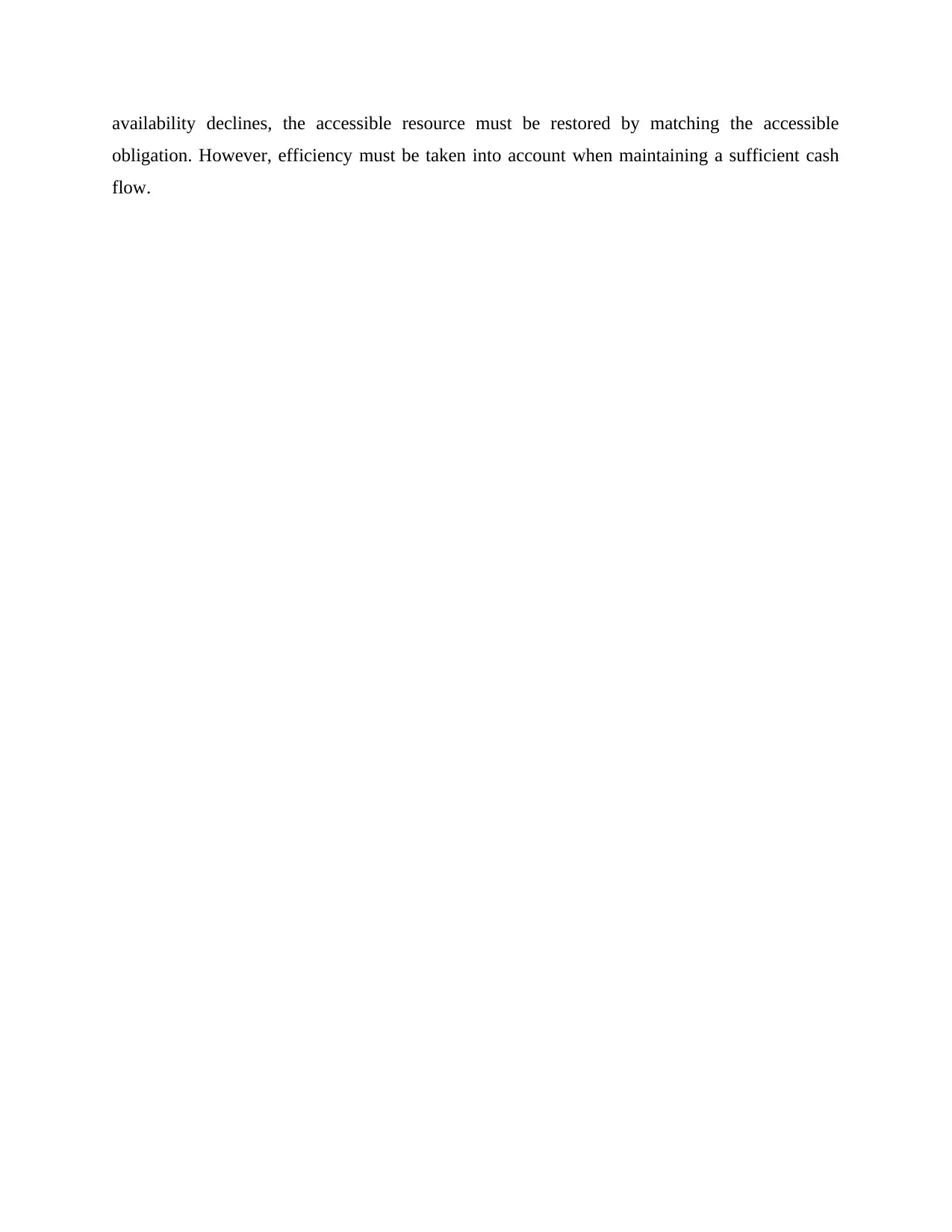
availability declines, the accessible resource must be restored by matching the accessible
obligation. However, efficiency must be taken into account when maintaining a sufficient cash
flow.
obligation. However, efficiency must be taken into account when maintaining a sufficient cash
flow.
Paraphrase This Document
Need a fresh take? Get an instant paraphrase of this document with our AI Paraphraser

REFERENCES
Books and journals
Firouzjah, K.G., 2018. Assessment of small-scale solar PV systems in Iran: Regions priority,
potentials and financial feasibility. Renewable and Sustainable Energy Reviews, 94,
pp.267-274.
Higgins, E.T. and Cornwell, J.F., 2016. Securing foundations and advancing frontiers:
Prevention and promotion effects on judgment & decision making. Organizational
Behavior and Human Decision Processes, 136, pp.56-67.
Kalkavan, H. and Ersin, I., 2019. Determination of factors affecting the South East Asian crisis
of 1997 probit-logit panel regression: The South East Asian crisis. In Handbook of
research on global issues in financial communication and investment decision making
(pp. 148-167). IGI Global.
Khemakhem, S. and Boujelbene, Y., 2018. Predicting credit risk on the basis of financial and
non-financial variables and data mining. Review of Accounting and Finance.
Liu, P., Liu, J. and Chen, S.M., 2017. Some intuitionistic fuzzy Dombi Bonferroni mean
operators and their application to multi-attribute group decision making. Journal of the
Operational Research Society, pp.1-26.
Nindito, M., 2018. Financial statement fraud: Perspective of the Pentagon Fraud model in
Indonesia. Academy of Accounting and Financial Studies Journal, 22(3), pp.1-9.
Shelton, V.M., Smith, T.E. and Panisch, L.S., 2019. Financial therapy with groups: A case of the
five-step model. Journal of Financial Counseling and Planning, 30(1), pp.18-26.
Tumataroa, S. and O'Hare, D., 2019. Improving self-control through financial counseling: A
randomized controlled trial. Journal of Financial Counseling and Planning, 30(2),
pp.304-312.
Books and journals
Firouzjah, K.G., 2018. Assessment of small-scale solar PV systems in Iran: Regions priority,
potentials and financial feasibility. Renewable and Sustainable Energy Reviews, 94,
pp.267-274.
Higgins, E.T. and Cornwell, J.F., 2016. Securing foundations and advancing frontiers:
Prevention and promotion effects on judgment & decision making. Organizational
Behavior and Human Decision Processes, 136, pp.56-67.
Kalkavan, H. and Ersin, I., 2019. Determination of factors affecting the South East Asian crisis
of 1997 probit-logit panel regression: The South East Asian crisis. In Handbook of
research on global issues in financial communication and investment decision making
(pp. 148-167). IGI Global.
Khemakhem, S. and Boujelbene, Y., 2018. Predicting credit risk on the basis of financial and
non-financial variables and data mining. Review of Accounting and Finance.
Liu, P., Liu, J. and Chen, S.M., 2017. Some intuitionistic fuzzy Dombi Bonferroni mean
operators and their application to multi-attribute group decision making. Journal of the
Operational Research Society, pp.1-26.
Nindito, M., 2018. Financial statement fraud: Perspective of the Pentagon Fraud model in
Indonesia. Academy of Accounting and Financial Studies Journal, 22(3), pp.1-9.
Shelton, V.M., Smith, T.E. and Panisch, L.S., 2019. Financial therapy with groups: A case of the
five-step model. Journal of Financial Counseling and Planning, 30(1), pp.18-26.
Tumataroa, S. and O'Hare, D., 2019. Improving self-control through financial counseling: A
randomized controlled trial. Journal of Financial Counseling and Planning, 30(2),
pp.304-312.
1 out of 11
Related Documents
Your All-in-One AI-Powered Toolkit for Academic Success.
+13062052269
info@desklib.com
Available 24*7 on WhatsApp / Email
![[object Object]](/_next/static/media/star-bottom.7253800d.svg)
Unlock your academic potential
Copyright © 2020–2026 A2Z Services. All Rights Reserved. Developed and managed by ZUCOL.



